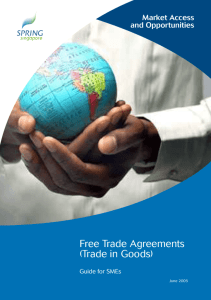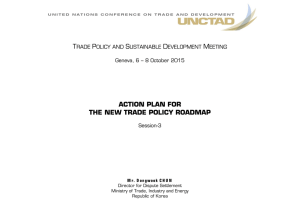DP On the Use of FTAs by Japanese Firms TAKAHASHI Katsuhide
advertisement
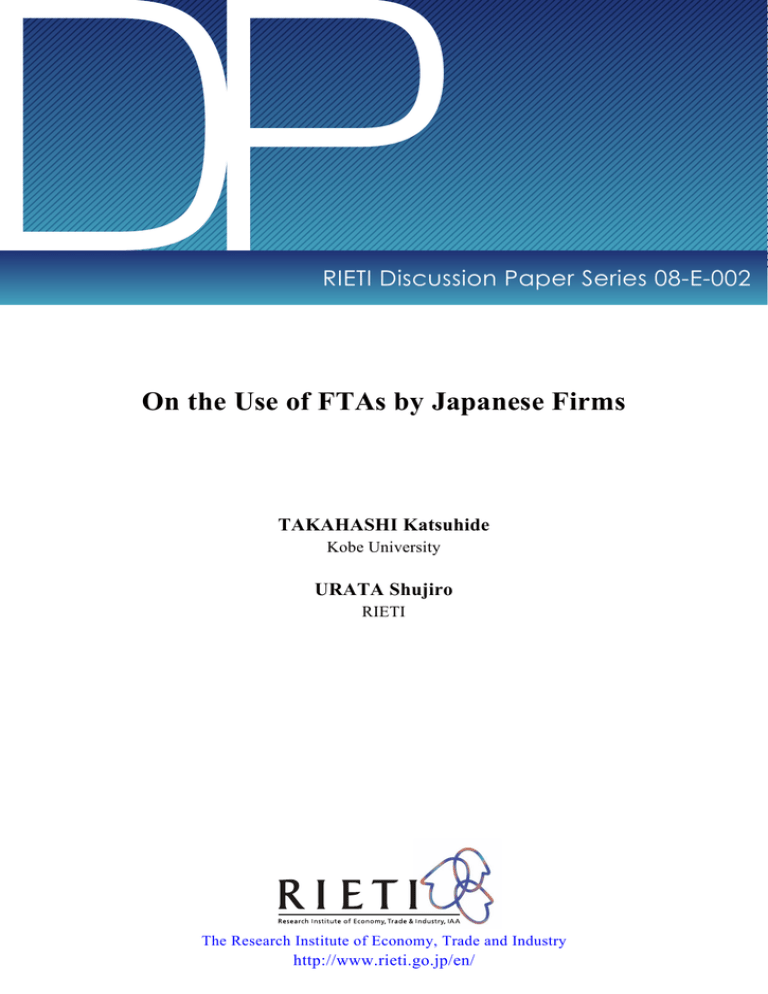
DP RIETI Discussion Paper Series 08-E-002 On the Use of FTAs by Japanese Firms TAKAHASHI Katsuhide Kobe University URATA Shujiro RIETI The Research Institute of Economy, Trade and Industry http://www.rieti.go.jp/en/ RIETI Discussion Paper Series 08-E-002 On the Use of FTAs by Japanese Firms January 2008 Katsuhide Takahashi* and Shujiro Urata ** Abstract The paper examines the use of free trade agreements (FTAs) by Japanese firms. The analysis utilizes information collected by way of a questionnaire survey. The analysis finds that the use of FTAs by Japanese firms is very limited. Many Japanese firms do not take advantage of free trade via FTAs as they think that benefits are small because their trade volume with FTA partner countries is small and because the tariff differentials between most favored nation (MFN) rates and FTA rates are rather small for many products. Probit analysis of the determinants of the use of FTAs reveals that large rather than small firms do use FTAs, reflecting the high cost of such practice. In addition, firms with close trade and FDI relationships with FTA partner countries are found to use FTAs. Our findings indicate the need to reduce costs of using FTAs in order to expand their use by simplifying application procedures and by providing assistance through public and semi-public institutions such as the Ministry of Industry, Trade and Economy (METI); the Japan External Trade Organization (JETRO); and the Japan Chamber of Commerce and Industry. The paper also argues that the Japanese government should establish FTAs with Japan’s large trading partners, including the United States and China. *Graduate School of Economics, Kobe University ** RIETI, Graduate School of Asia-Pacific Studies, Waseda University An earlier version of this paper was prepared for and presented at the RIETI International Symposium, “Assessing Quality and Impacts of Major Free Trade Agreements” on March 22-23, 2007. The authors would like to thank Hidehiro Okayama and other participants at the symposium and Masahisa Fujita, Ryuhei Wakasugi, and Masahiko Ozaki at RIETI study workshops for their helpful comments. The authors would also like to acknowledge Ryoji Asano and the Osaka Chamber of Commerce for providing useful information. Introduction The purpose of this paper is to evaluate Japan’s existing free trade agreements (FTAs) from a user viewpoint. The paper analyzes data based on a questionnaire survey concerning the use of preferential tariff schemes under FTAs. In addition to making some observations on the use of FTAs by Japanese firms, we try to identify the determinants of this use by conducting an econometric analysis. As of July 2007, 143 FTAs were in effect worldwide. In the 1990s, 48 agreements were formed and 76 new agreements have been created since 2000. Such acceleration in new FTAs is caused by the fact that WTO negotiations have been slow to bear fruit and thus an increasingly large number of countries started to pursue FTAs as a supplement (Japan External Trade Organization 2007b). As of November 2007, Japan had already concluded several FTAs. The Japan-Singapore FTA went into force in November 2002; Japan-Mexico in April 2005; Japan-Malaysia in July 2006; Japan-Chile in September 2007; and Japan-Thailand in November 2007. The Japan-Singapore FTA is historically important, as Munakata (2006) pointed out, in that it was clear that unless Japan could conclude an FTA with Singapore, it would not be able to implement any further FTAs. Now that five years have passed since the enactment of the Japan-Singapore FTA, and more than two years since the Japan-Mexico EPA, the time has come for assessment. According to The Economist (Aug. 23, 2007), Japan’s FTAs with East Asian countries are no doubt intended to lessen Japan's dependence on the US economy. But it is also aimed in part at counterbalancing a similar campaign by China to improve its regional influence and its access to Southeast Asian markets. However, recently some critics have questioned whether FTAs are being fully utilized by Japanese firms, especially by small- and medium-sized companies. The tariff preferences offered by FTAs have reportedly been eroded by the complicated rules of origin and the related compliance costs. In response to these questions, several questionnaire surveys have been conducted to analyze the use of FTAs by Japanese firms. For example, the Japan Bank for International Cooperation (2005) reports that 13.5% of Japanese firms used the ASEAN Free Trade Area (AFTA), 6.6% used the China-ASEAN FTA, and 5.5% used the Japan-Singapore FTA. According a the survey by the Japan External Trade Organization (2007a), 5.1% of exporters (37 of 729) utilized preferential tariff schemes under FTAs already in effect in the Asia Pacific region (AFTA, Japan-Malaysia FTA, Thailand-Australia FTA, etc.) When firms were asked to name FTA(s) under which preferential tariff scheme(s) were being utilized, the AFTA was cited most (24 firms), followed by the Japan-Malaysia (15 firms) and Thailand-Australia (8 firms) FTAs. These results show the low utilization of FTAs by Japanese firms. As mentioned, this paper attempts to analyze the use of FTAs by Japanese firms by using the results of the questionnaire survey. Section 2 gives a brief description of the survey before examining its results concerning use, difficulty in 1 utilizing FTAs, etc., while section 3 conducts an econometric analysis to identify the determinants or characteristics of the firms using FTAs. Section 4, the final section, presents some concluding remarks. 2. Use of FTAs by Japanese Firms: Survey results 2.1 Questionnaire In November 2006, the Osaka Chamber of Commerce and Industry, as well as those in Kobe and Kyoto, along with the JETRO Osaka branch, jointly conducted a survey on the use of FTAs by Japanese firms.1 They conducted this survey because they suspected that the application for certificates of origin, which is required to take advantage of preferential tariffs under FTAs, had been in some areas less active than expected. A questionnaire was e-mailed to 4,204 member companies, of which 469 responded, a response rate of 11.2%. The attributes of the responding companies are described in detail in the Appendix. This survey was designed to reveal the behavior of Japanese firms in their use/non-use of FTAs. Therefore some of the questions in the survey are very straightforward such as, “Have you used FTAs?”, and “If not, why?” 2.2 Utilization Rate of FTAs Table 1 shows the utilization rate of three FTAs: Japan-Singapore, Japan-Mexico, and Japan-Malaysia. In the case of the Japan-Singapore FTA, which went into effect in November 2002, only 17 of the 469 responding firms reported using it, for a utilization rate of a mere 3.6%, which is comparable to the 5.5% in the JBIC survey. In order to grasp the utilization rate more accurately, it might be better to exclude the firms that reported no trade relationship with Singapore as they had no reason to use the FTA. After making this adjustment, the utilization rate increased only slightly, to 4.6%. The low utilization is probably due to the fact that there is no reason for Japanese firms to use the Japan-Singapore FTA since most products imported from Japan to Singapore enjoy tariff-free treatment. In case of the Japan-Mexico FTA, 59 of the 469 firms reported using it, a rate of 12.6%. This goes up to 17.6% after we exclude the firms with no trade relationship with Mexico. Many companies use the FTA for export to Mexico and only one company uses the FTA for import from Mexico. This observation reflects the fact that Japanese export-oriented automobile and steel companies were actively using the FTA with Mexico. In the case of the Japan-Malaysia FTA, 26 of 469 firms reported using the FTA, a rate of 5.5%. This rises to 7.0% after excluding the firms with no trade relationship with Malaysia. Utilization may be biased downward due to the 1 Those who wish to apply for certificate of origin, regardless of the type of application, corporation, or individual, need to follow the procedure for "registration of applicants for certificates related to international trade." Completion of the procedure is required for all applicants, regardless of membership or non-membership in the Chamber of Commerce. 2 relatively recent enactment of the agreement. It is interesting to note that around half the respondents reported hearing of the FTAs but had no experience using them. Approximately a quarter (Japan-Singapore and Japan-Malaysia FTA) and a third (Japan-Mexico FTA) of the total respondents reported never having heard of the FTAs. These findings indicate the need for the Chamber of Commerce and JETRO to promote the use of FTAs to Japanese companies. Table 1. Utilization of FTAs Classification Singapore Mexico Malaysia Have used FTAs (total) 17 3.6% 59 12.6% 26 5.5% <Both export and import> 8 1.7% 8 1.7% 8 1.7% <Export> 5 1.1% 45 9.6% 10 2.1% <Import> 3 0.6% 1 0.2% 7 1.5% <Others> 1 0.2% 5 1.1% 1 0.2% Have heard of FTAs but have not used any 246 52.5% 205 43.7% 237 50.5% Never heard of FTAs but have interest 57 12.2% 21 4.5% 56 11.9% Never heard of FTAs and have no interest 119 25.4% 150 32.0% 121 25.8% No answer 30 6.4% 34 7.2% 29 6.2% Total 469 469 469 2.3 Reasons for Low Utilization Rate In this section, the reasons for firms not using FTAs will be discussed. Table 2 shows some of these reasons. As was shown in the previous section, many companies have heard of FTAs but never used them, and the questionnaire addressed this issue. Many firms have no incentive to use FTAs. A large number of respondents answered that their trade with these three countries is so small they cannot see that paying the cost of obtaining necessary documents for using the relevant FTA would yield them any profit. This answer gets at the heart of the problem. Although these three countries are important trading partners for some Japanese companies, in terms of volume of trade they are not necessarily as important as countries like China and the United States. Mexico accounted for a mere 1.4% of Japan’s overall exports in 2006, with 3 Singapore and Malaysia each at 2.0%. Almost a quarter of companies answered that they do not use FTAs because they do not know them in detail or know how to use them.2 Table 2. Reasons for not using FTAs Singapore Mexico Malaysia Lack of knowledge/or do not know how to use 56 22.8% 33 16.0% 57 24.1% Complicated procedures in acquiring certificate of origin 2 0.8% 3 1.5% 7 3.0% Tariff preference by FTAs is too small and have no incentive to use EPA 9 3.7% 2 1.0% 5 2.1% Already have preferential treatment with trading partners without FTAs 2 0.8% 0 0.0% 0 0.0% Trade volume with trading partner is very small and have no incentive to use FTAs 125 50.8% 112 54.6% 111 46.8% Other 43 17.5% 37 18.0% 37 15.6% No answer 9 3.7% 18 8.8% 20 8.4% Total 246 205 237 Reasons These findings indicate that existing FTAs are not attractive for many Japanese companies. Mexico and Malaysia are not necessarily major trading partners for many Japanese companies. Singapore is a different story, as will be discussed below. Asked about the important trading partners, the respondents indicated China as the most important trading country (Table 3); 129 companies ranked China highest, while 81 firms chose the United States and 40 firms placed Korea at the top. Following in perceived importance were Taiwan, Singapore, Hong Kong, Indonesia, and Thailand. Traditionally, Mexico and Malaysia have not been regarded as important trading partners for Japanese firms. Singapore is cited as major trading partner by some companies. Therefore, a question is why Japanese firms do not use the Japan-Singapore FTA despite some answering that Singapore is one of the important trading partners. This is because Singapore has low tariff protection on imports from Japan, reducing the need for Japanese companies to use the FTA.3 Contrary to expectations of the researchers, few companies answered that complicated application procedures are an obstacle. 3 In addition to trade, overseas bases are concentrated in China, the United States, and Thailand. In terms of production, China, Thailand, the US, and Indonesia are the important bases for Japanese firms. Singapore is utilized as a base for sales and local headquarters 2 4 Table 3. Major trading partners of respondents (multiple answers) first China 129 United 81 Korea 40 Taiwan 27 States Second China 71 United Hong 24 Indonesia 13 29 Hong 27 Kong 44 Korea 43 Taiwan 34 Thailand States Third Taiwan 46 Korea Kong 43 United 33 Thailand 29 China 28 Singapore 27 24 Thailand 22 Singapore 22 United 14 States Fourth Korea 30 Taiwan 29 China States Fifth Taiwan 32 United 17 Singapore 17 Thailand 15 China 15 Indonesia 14 States 2.4 Impacts of FTAs on Japanese Companies Do FTAs have positive effects on businesses? The results of responses regarding the Japan-Mexico and Japan-Malaysia FTAs are shown in Table 4.4 Approximately 20% of the respondents indicated an increase in sales, while a majority indicated no change in sales or no clear effects. It seems the FTAs have positive effects on businesses, but it is still too early to make a conclusive assessment. Regarding difficulty or ease of using FTAs, some companies complained that the procedure of filling application forms takes a long time and is costly, thus they do not use FTAs. Many respondents did indicate no major problems, but a number of respondents appeared to have some sort of issue (Table 5). The proportion of respondents with complaints was larger in the case of the Japan-Malaysia FTA than the Japan-Mexico FTA. This difference may be due to the longer time in which the Japan-Mexico FTA has been in operation compared to the Japan-Malaysia FTA. Table 4. Effects of FTAs with Mexico and Malaysia on Business Classification Increase of sales Increase of sales but no change of profit No change of sales Increase of cost and decrease of profit No clear effect thus far No answer Total Mexico 7 5 16 2 28 1 59 Rate (%) 11.9 8.5 27.1 3.4 47.5 1.7 100.0 Small Should be Malaysia 3 2 8 0 13 0 26 Rate (%) 11.5 7.7 30.8 0.0 50.0 0.0 100.0 Table 5. Assessment of the Use of FTAs No problem 4 No major No Total (see Table A10 in the appendix). Note that Singapore was ruled out from the analysis in this section because the number of respondents was so small and contains some extraordinary figures. 5 problem problem revised answer Mexico (%) 8.5 50.8 25.4 10.2 5.1 100.0 Malaysia (%) 3.8 34.6 50.0 3.8 7.7 100.0 2.5 Attractive FTA Partners Respondents were asked about their interests in future FTA partner countries. (Table 6). This question was asked about the two groups of countries; one group with which Japan is currently negotiating FTAs (Table 6) and the other with which it is not (Table 7). Among the countries in the first group, many companies are eagerly expecting the conclusion of FTAs with Vietnam, ASEAN, Korea, India, and Indonesia. For future FTAs, Japanese companies have a very strong interest in an FTA with China, followed by the one with the US. Table 6. Attractive FTA Partner Countries (currently under negotiation) How much are you interested? Fields of interest (multiple answer) Greatly Fairly Not so No Export Import Investment Human Countries much interest Others capital Korea 89 175 81 48 226 141 12 13 12 Indonesia 62 145 86 87 187 81 17 11 16 Brunei 9 38 106 207 80 21 10 3 14 Vietnam 98 165 73 58 186 116 54 32 19 ASEAN 94 183 77 30 217 132 36 27 20 India 86 172 68 53 195 107 33 22 18 Asian Community 69 205 74 52 197 126 39 23 16 Chile 22 54 102 188 94 23 5 2 11 GCC 48 103 82 134 153 32 9 5 14 Australia 47 134 88 89 168 51 14 8 15 Switzerland 23 77 112 153 104 45 8 7 16 Table 7. Attractive FTA Partner Countries (not currently under negotiation) Countries Numbers Fields of interest (multiple answer) Export Import Investment Human Others Capital China 55 41 39 15 8 6 United States 27 24 7 3 1 1 Taiwan 14 14 9 1 2 1 Brazil 14 13 4 4 0 0 3. Determinants of the Use of FTAs: An application of the probit model In this section we examine the determinants of the use of FTAs by Japanese companies. We are interested in modeling the decision of a firm on whether or not to 6 use an FTA. For the analysis we apply the probit model. In this model, the dependent variable, y , may take on only two values; zero or unity. If the firm chooses to use an FTA, then y is set to unity. If the firm decides not to use an FTA, then y is given zero5. A set of explanatory variables, x, include the characteristics of the firms and industries.(Table 7) As the explanatory variables related to firm characteristics, we choose the size of a firm, measured by the amount of paid-in capital (CAP), and the number of employees (EMP). We also include the information on overseas activities of a firm; overseas sales ratio (ROS) defined as the ratio between overseas sales to overall sales (domestic and overseas sales), the ownership of an overseas affiliate in an FTA partner country (BSG), and information on the importance of an FTA partner country as an important trading partner (TSG). For industry characteristics, we include a manufacturing industry dummy (MAN). Table 7. Definition of explanatory variables and expected sign Expected sign Variable Definition name Assigned values MAN Type of industry =1,if firm is a manufacturer, =0, otherwise ? CAP Scale of capital =1 firm’s capital is more than ¥1 billion, =0, otherwise + EMP Number of employees =1,if firm employs more than 100 workers, =0, otherwise + ROS Ratio of overseas sales =1,if firm’s overseas sales is more than 50%, =0, otherwise + BSG =1,if firm has a business base (production, Owning business bases sales, or other) in Singapore, Mexico, or in Singapore, Mexico, or Malaysia Malaysia =0, otherwise + TSG Singapore, Mexico, or =1,if firm has strong trade relationship with Malaysia is a major Singapore, Mexico, or Malaysia trading partner? =0, otherwise + The probit model is formally defined as Pr(y=1|x) = Φ(xb) where Φ is the standard cumulative normal probability distribution and xb is the probit score or index. Since xb has a normal distribution, interpreting probit coefficients requires thinking in the Z (normal quantile) metric. The interpretation of a probit coefficient, b, is that a one-unit increase in the predictor leads to increasing the probit score by b standard deviations. The log-likelihood function for the probit is 5 where wj denotes optional weights. 7 Based on our recognition that large companies have abundant resources such as labor and capital, which are required to use FTAs, we expect the estimated coefficients on CAP and EMP to be positive. We expect the signs of the coefficients on ROS, ESG, and TSG to be positive, because a company which depends on its business in an FTA partner country is likely to use an FTA. To statistically discern the determinants of the use of an FTA, we conducted a probit estimation by applying several specifications. The results are shown in Table 8. Table 8. Determinants of the Use of FTAs MacFadden Mexico Malaysia Singapore Ⅰ Ⅱ Ⅲ Ⅳ Ⅴ Ⅵ Ⅰ Ⅱ Ⅲ Ⅳ Ⅴ Ⅵ Ⅰ Ⅱ Ⅲ Ⅳ Ⅴ Ⅵ c MAN CAP -1.46*** -1.57*** -1.46*** -1.57*** -1.41*** -1.48*** -2.06*** -2.19*** -2.06*** -2.22*** -2.10*** -2.22*** -2.11*** -2.24*** -2.08*** -2.18*** -2.04*** -2.11*** 0.26 0.19 0.26 0.19 0.23 0.15 -0.17 -0.27 -0.17 -0.27 -0.15 -0.27 -0.16 -0.26 -0.18 -0.28 -0.15 -0.23 0.34* EMP 0.41** 0.34* 0.41** ROS BSG TSG R-squared obs. 0.10 0.16 0.10 0.15 0.00 -0.11 -0.08 0.02 -0.09 0.02 0.09 0.30 0.05 0.65 0.70** 0.63*** 0.70** 0.64** 0.80*** 0.76*** 1.90*** 1.93*** 1.9*** 1.92*** 1.93*** 1.96*** 0.79*** 0.71*** 0.83*** 0.81*** 0.81*** 0.81*** 0.33 0.31 0.25 0.30 0.09 0.09 0.09 0.09 0.09 0.09 0.18 0.14 0.18 0.13 0.18 0.13 0.14 0.12 0.14 0.12 0.13 0.11 452 452 452 452 452 452 456 456 456 456 456 456 452 452 452 452 452 452 0.33* 0.38** 1.04*** 0.83*** 1.06*** 0.94*** 1.07*** 0.93*** 0.77*** 0.72*** 0.77*** 0.70*** 0.76*** 0.66*** *** shows the figures are statistically significant at 1%, **5%, and *10%. McFadden R-squared is a likelihood ratio index that is an analog to the R-squared reported in linear regression models. It always lies between zero and one. The results show that large companies tend to use FTAs because the estimated coefficients on size, either measured by magnitude of paid-in capital (CAP), or by employment (EMP), are positive and statistically significant for all cases. As we postulated above, the use of FTAs appears to require a sufficient amount of human, financial, and other resources for obtaining certificates of origin. Furthermore, economies of scale are likely to play an important role in the use of FTAs. More concretely, a single copy of a certificate of origin can be used for exporting a product regardless of its amount. As such, it may be profitable for an 8 exporter to export a large amount of the same product because one certificate of origin can be used for any amount of exports for the same product. A comparison of the magnitude of the estimated coefficients on CAP and EMP for different FTAs reveals large-sized firms are most significant in the case of the Japan-Malaysia FTA, while firm size matters least in the case of the Japan-Mexico FTA. The Japan-Singapore FTA resides somewhere between the other two. An examination of the utilization of FTAs by large and small firms for the three FTAs shows consistent patterns. Specifically, FTA utilization rates for large firms for the Japan-Mexico, Japan-Malaysia, and Japan-Singapore FTAs are 16.3%, 16.3%, and 10.5% respectively, while the corresponding rates for small firms are 11.7%, 2.5% and 1.9%. Tests of the differences in these rates between large and small firms reveal a statistically significant difference for the Japan-Malaysia and Japan-Singapore FTAs, but no statistical difference for the Japan-Mexico FTA. These findings may indicate that obtaining a certificate of origin for the Japan-Mexico FTA is easier than for the others, enabling even small firms to utilize it. We need to investigate this issue further. The findings on the estimated coefficients on BSG show that a firm owning an affiliate in an FTA partner country tends to use the corresponding FTA in the case of the Japan-Singapore FTA, while such a relationship is not found to be statistically significant in the case of the Japan-Mexico or Japan-Malaysia FTAs. This finding may reflect that FTAs are used for intra-firm trade. Indeed, if both the exporter and importer belong to the same firm, the benefit of using an FTA may be more easily reaped. For TSG, we found that a firm with a strong trade relationship with an FTA partner country tends to use that FTA, as we expected. This relationship is statistically significant in the cases of the Japan-Mexico and Japan-Malaysia FTAs. Though a positive sign for TSG was found for the Japan-Singapore FTA, the relationship is not statistically significant. 4. Concluding Remarks An examination of the use of FTAs by Japanese firms by way of a questionnaire survey revealed that only 3%-13% of the responding firms have used Japan’s FTAs with Singapore, Mexico, or Malaysia. One reason for the limited use of these FTAs by Japanese firms is the low volume of trade with these FTA partner countries. Another reason is the limited benefits of using FTAs for many products because tariff rates on such products are quite low. Asked about attractive FTA partners, many firms indicated China, the US, and Korea. The results of a statistical analysis of the determinants of the use of FTAs by using firm-level data found that large firms are likely to use FTAs while small firms do not use them. This finding appears to indicate that the use of FTAs requires labor and other resources in order to prepare the necessary documents such as certificates of origin. In addition, firms with close trade and FDI relationships with 9 FTA partner countries were found to be using FTAs. Our findings indicate the need to reduce the costs of using FTAs in order to expand their use. This is especially important for small firms, as they cannot afford to spend great resources in order to obtain necessary information and/or documents. It is important to simplify the application procedure and provide assistance for the use of FTAs through public and semi-public institutions such as the Ministry of Industry, Trade and Economy (METI); the Japan External Trade Organization (JETRO); and the Chamber of Commerce. Finally, it should be pointed out that the Japanese government should establish FTAs with Japan’s large trading partners, including the US, the EU, and China. 10 References Japan Bank of International Cooperation (2005), Report on Japanese Manufactures’ Overseas Business Operations FY 2005 Survey: Outlook for Japanese Foreign Direct Investment Japan External Trade Organization (2007a), FY 2006 Survey of Japanese Firms’ International Operations Japan External Trade Organization (2007b), White Paper On International Trade and Foreign Direct Investment 2007 Munakata, N. (2006) Transforming East Asia, Brookings Institution Press 11 Appendix 1: Characteristics of Questionnaire Respondents Table A1. Location of Respondents Number Rate (%) Osaka Kyoto Hyogo 347 74.0 24 5.1 40 8.5 Other Kansai Area 7 1.5 Others Unknown Total 31 6.6 20 4.3 469 100.0 Table A2. Type of Industry Manufacturing Number 205 Rate 43.7 (%) Trade & Finance Transportation Service Others Commerce Unknown Total 191 40.7 18 3.8 469 100.0 0 0.0 13 2.8 15 3.2 27 5.8 Table A3. Paid-in Capital Less than ¥100 million 239 51.0 Number Rate (%) ¥101 million-¥500 million 66 14.1 ¥501 million-¥1 billion 11 2.3 More than ¥1 billion Unknown Total 86 18.3 67 14.3 469 100.0 Table A4. Number of Employees Less than 20 Number 125 Rate 26.7 (%) 20-49 50-99 100-499 500-999 58 12.4 63 13.4 116 24.7 37 7.9 1,000 or more 51 10.9 Unknown Total 19 4.1 469 100.0 Table A5. Major Commodities (multiple answers) Metal Machin Electronics ery Transportation Textile machinery Chemical Food Sundries Others Total 469 100.0 products Numbers 64 135 85 58 75 106 43 56 125 Rate (%) 13.6 28.8 18.1 12.4 16.0 22.6 9.2 11.9 26.7 12 Table A6. Foreign Trade Number Rate (%) Conducting Domestic foreign trade trade only 435 92.8 33 7.6 Unknown Total 1 0.2 469 100.0 Table A7. Proportion of Foreign Trade in Total Ssles 90% and above 75%-89% 50%-74% 25%-49% 10%-24% Below 10% Unknown Total Number 71 36 57 72 79 117 3 469 Rate 15.1 7.7 12.2 15.4 16.8 24.9 0.6 100.0 (%) Table A8 Trading Partner Countries of Respondents (number, multiple answers) First China 129 United 81 Korea 40 Taiwan 27 States Second China 71 United Hong 24 Indonesia 13 29 Hong 27 Kong 44 Korea 43 Taiwan 34 Thailand States Third Taiwan 46 Korea Kong 43 United 33 Thailand 29 China 28 Singapore 27 24 Thailand 22 Singapore 22 United 14 States Fourth Korea 30 Taiwan 29 China States Fifth Taiwan 32 United 17 Singapore 17 Thailand 15 China 15 Indonesia States Table A9. Overseas Affiliates Number Rate (%) Owning overseas affiliates 246 52.5 Planning to establish overseas affiliates 67 14.3 No concrete plan 103 22.0 No interest 48 10.2 Unknown 5 1.1 469 100.0 Total 13 14 Table A10. Overseas Affiliates and Their Functions Number of affiliates Types of the business activity (multiple answers) Production Sales Local headquarters Procurement Others China 166 102 92 9 21 24 United States 95 34 75 16 7 15 Thailand 68 41 48 6 10 9 Singapore 37 9 34 7 4 3 Hong Kong 36 0 31 3 2 7 Taiwan 32 16 22 1 3 6 Korea 31 8 26 1 5 6 Indonesia 27 21 15 1 1 3 Malaysia 26 14 19 2 2 4 Vietnam 14 10 5 0 1 4 Philippines 5 3 3 0 0 1 14

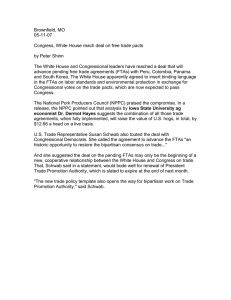
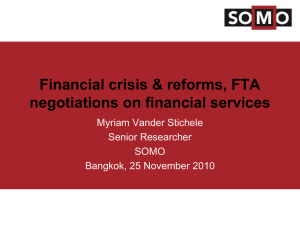
![a Global Challenge by David Vines [PPT 235.00KB]](http://s2.studylib.net/store/data/009971398_1-15c88e7b8aa0616f618737539dc01e97-300x300.png)
